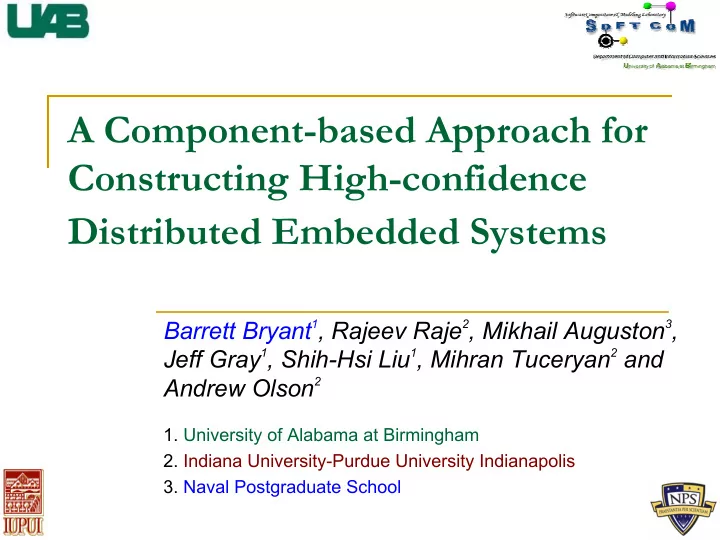

A Component-based Approach for Constructing High-confidence Distributed Embedded Systems Barrett Bryant 1 , Rajeev Raje 2 , Mikhail Auguston 3 , 2 and Jeff Gray 1 , Shih-Hsi Liu 1 , Mihran Tuceryan Andrew Olson 2 1. University of Alabama at Birmingham 2. Indiana University-Purdue University Indianapolis 3. Naval Postgraduate School
Realizing Distributed Embedded Systems Using Service-Oriented Architectures � DES as a composition of heterogeneous, independently developed components � Each component offers services along with associated assurances about them. � Confidence characteristics incorporated during design, construction, deployment, and composition of these services � Cost of verification and validation reduced
Research Goals Develop service-oriented models for DES which � incorporate high-confidence characteristics such as correctness and QoS Develop, discover and select components using � service-oriented models, so that components and their ensemble exhibit high confidence Automate the composition of components to � minimize vulnerability arising from handcrafting Validate the assembled DES with respect to both � functional correctness and QoS
Key Research Issues � Architecture-based Interoperability � Automation, standardization, mappings and tools � Distributed Resource Discovery � Specification, publication, distribution, selection � Validation of Quality Requirements Vocabulary and associated metrics, composition, � monitoring Main Challenge: Heterogeneity Main Challenge: Heterogeneity
UniFrame Knowledge Base � Developed by domain experts for specific application domains � Describes service-oriented architecture for the application � Specifies functional and QoS properties of components that make up the architecture � Discovers and matches components to the requirements � Automatically generates code for interoperation of components � Predicts and empirically measures vulnerability properties of the integrated system
Formal Methods � Language for describing rules for integrating components – Two-Level Grammar (TLG) � Automated scenario generation from environment models – Attributed Event Grammar (AEG)
Two-Level Grammar � TLG consists of two context-free grammars corresponding to the set of type domains and the set of logical rules operating on those domains. � The first level of the grammar, called meta-rules , defines the structure of the domain, including the syntactic interfaces of components. � The second level of the grammar, called hyper- rules , defines the rules for composing components, performing static evaluation of QoS constraints, and generation of connector code.
TLG Example ClientUMM , ServerUMM :: UniframeMetaModel . ClientOperations , ServerOperations :: { Interface }*. generate Application system from ClientUMM and ServerUMM with QoS : ClientOperations := ClientUMM get operations, ServerOperations := ServerUMM get operations, OperationMapping := map ClientOperations into ServerOperations using Application domain, ComponentModel := ServerUMM get component model, generate java code for OperationMapping using ComponentModel with QoS .
TLG Glue/Wrapper Generation Connector Java RMI CORBA Client Server Proxy Proxy client server TLG specification for TLG specification for Java RMI Client CORBA Server Knowledge base
Attributed Event Grammar � Attributed event grammar (AEG) provides a uniform approach for automatically generating, executing, and analyzing tests. � Quantitative and qualitative risk assessment can be performed based on statistics gathered during automatic test execution. � AEG provides automated testing of distributed real-time embedded software systems, based on modeling the environment in which a system will operate.
AEG Example � Shoot ::= Fire ( p(0.3) Hit /Send_input_to_SUT (Hit . time)/ | p(0.7) Miss ) � Large number of Shoot scenarios can be generated. � Each event trace will satisfy the constraints imposed by the event grammar.
How to AEG Validation monitor the results E nvironment Run time model Generator monitor repres ented a s an event gramma r How to S UT create test Tes t driver cases (in C or assembly language) How to run test case
Case Study – Mobile Augmented Reality Interaction Trackers HMD GPS Soldier Wireless Device Hand Tracker Rifle Computation Environment Model Store Battlefield Environment Data DoD Assign Strategies
Conclusions � Development and reuse of existing software components for embedded systems in a manner that fosters high-confidence � Partially automates the software design and validation process for embedded systems, thereby increasing reliability � Assists in the development of standards for software component descriptions in embedded domains
Future Work � Expand case studies to include other domains � Develop prototype tool suites to further validate framework
Further Information http://www.cs.iupui.edu/uniFrame
Recommend
More recommend